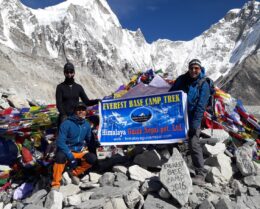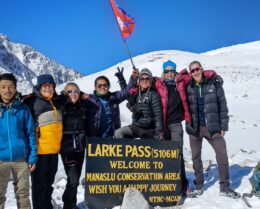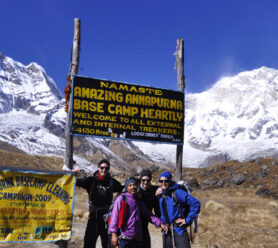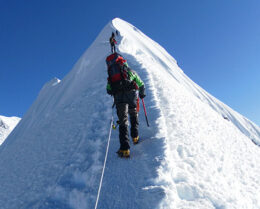Exploring 5 Highest Passes in Nepal- An Adventure Guide
UPDATED ON 4 March, 2024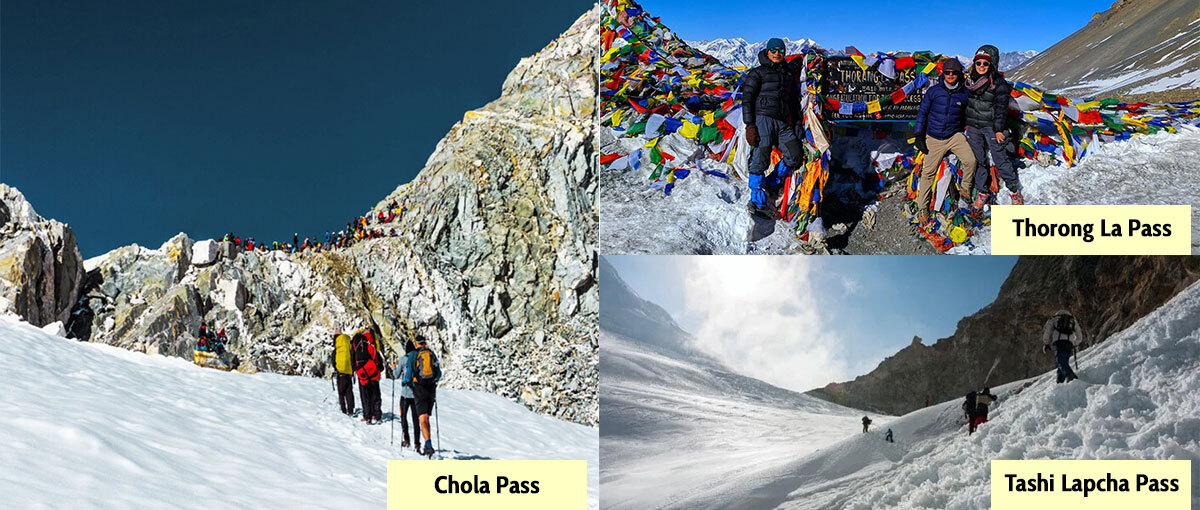
Trekkers looking for adventure and stunning views will find paradise in Nepal’s rough terrain. The many trekking alternatives available in this Himalayan beauty are particularly exciting and hard, especially the high pass hikes. Additionally, these paths lead you through secluded areas, charming towns, and high mountain passes with breathtaking vistas. We explore the appeal of 5 of the most well-liked Highest Passes in Nepal in this blog.
Thorong la pass, Chola la pass, Renjo la pass, Larke La Pass, and Tashi Lapcha Pass. As you travel across these magnificent Himalayan passes, you’ll be thrust into a world of breathtaking natural beauty, cultural experiences, and personal victories.
1. Thorong La Pass – An Annapurna Classic
At 5416 meters (17,769 feet), above sea level, Thorong La Pass is the widest mountain pass in the world. This pass is located in Nepal’s Annapurna Conservation Area, to the north of Mount Annapurna. The Thorong La Pass Trek takes you across the world’s most famous pass, which is both breathtakingly beautiful and rather difficult. You will undoubtedly be rewarded with the view of majestic mountains with varying heights and significance when you trek the Thorung La Pass.
The Thorong La Pass Trek is undoubtedly among the top hikes in Nepal. Trekkers who want to experience the breathtaking vistas and topography of the northern and southern Himalayas should choose this route. You will see the stunning vistas of Marsyangdi Valley, the verdant Annapurna Conservation Area Project, the rural way of life and culture of the Nepali peasants, and much more on this journey.
You can also get some breathtaking views of the Himalayan peaks, which rise to a height of over 6,000 meters, on this hike. Snow-capped Mt. Manaslu (8,187 m), Mt. Annapurna, Mt. Hiunchuli, Mt. Gangapurna, Mt. Nilgiri, Mt. Dhaulagiri, and numerous other Himalayan peaks are all visible in this breathtaking view.
The highlight of the Thorong La Pass Trek is crossing over Thorong-La Pass (5,416m). Views of the magnificent Upper Mustang region, a restricted area, and Mustang peak, Mt. Dhaulagiri (8,167 m), are breathtaking from the pass.
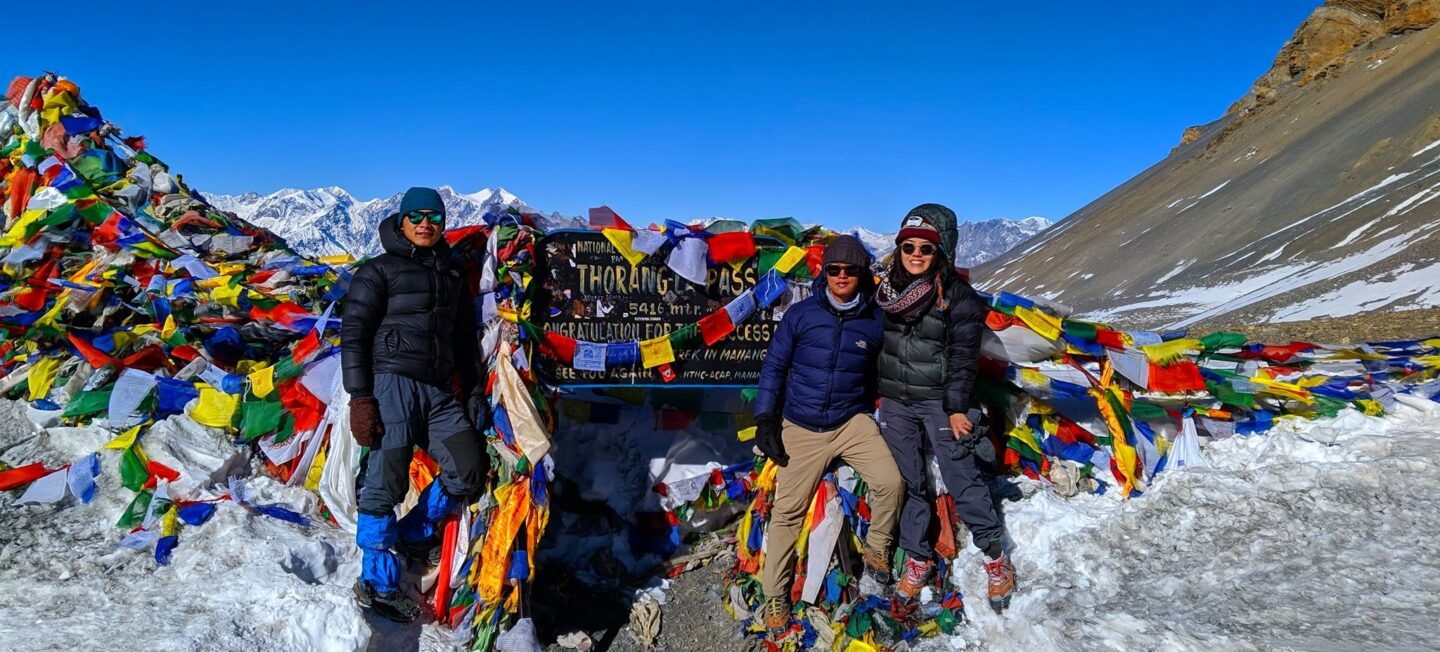
The best time for the visit to Thorong La Pass
The peak season of autumn lasts from October until mid-December. This was the time I did the majority of my Himalayan treks. Clear skies, breathtaking vistas of the snow-capped peaks, and dry hiking pathways are all enjoyed in the fall.
The valley has pleasant, mild weather all year round, with daytime highs of 77°F (25°C) and nighttime lows of below zero when you’re over 11,480 feet (3,500 meters). Spring, the second half of the busiest trekking season, is equally breathtaking. This time of year usually brings warmer temperatures along with occasionally foggy sights. Expect some rain in May as the dry season is coming to an end. Rainfall turns to snow over 11,480 –13,100 feet (3,500 – 4,000 meters).
In the highlands, springtime mornings are clear and sunny, but between noon and two in the afternoon, the weather frequently shifts drastically. To ensure that you finish your walk before the afternoon, make sure you have plenty of layers and be prepared to set out early. Still, trekkers visiting the Himalayas in March or April will be rewarded with breathtaking views of the rhododendron blossoms on the slopes.
2. Cho La Pass: Gateway to Everest
Cho La, a summit pass, sits at an altitude of 5,420 meters (17,782 ft) above sea level in the Solukhumbu District of northeastern Nepal. A true expedition into the heart of the Everest region, the Everest Base Camp via Gokyo-Chola Pass Trek triumphs over one of the highest passes in the world, Chola Pass.
We have the chance to see the enchanting Gokyo Valley, which sits on the edge of the tranquil Gokyo Lake, on this trek. In addition, visitors can trek up Gokyo Ri’s summit, which provides breathtaking views of the whole Everest Himalayan range.
The exhilarating experience of traversing Chola Pass will last a lifetime. Trekking to Everest Base Camp via Gokyo-Chola Pass is another excellent way to get a taste of Sherpa culture. In addition to this, Sagarmatha National Park, home to alpine flora and fauna, is traversed during this expedition. Other features of this hike include the high pasturelands, natural cascades, and vistas.
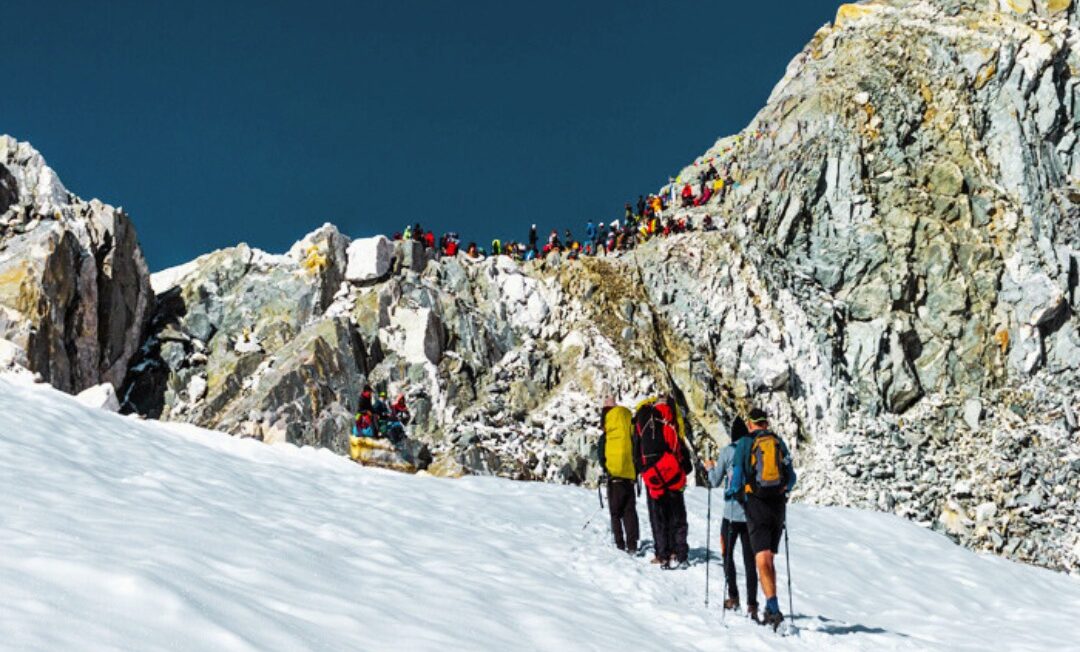
Highlights of the trek
- Breathtaking views of the Everest region through the mountains.
- Trekking to Kalapathar and enjoying a pleasant stroll after crossing Cho La Pass (5,420 m) and taking in the breathtaking 360-degree view of the Himalayas; then, take a scenic mountain flight to Lukla and Kathmandu.
- Traveling through distinctive Sherpa communities and encountering Gompas and monasteries along the way.
How to get to Chola Pass
Like other trekking pathways in the Everest region, the Everest Base Camp Via Gokyo-Chola Pass trek begins in Lukla following a quick and picturesque flight from Kathmandu, landing there and providing some background information on the Everest region.
After that, the trail climbs to Phakding from Namche. The entry point to Sagarmatha National Park, a UNESCO World Heritage site, is Manjo. Inside the park are numerous rare and endangered species of flora and fauna, including red-billed chough, pheasant, blood pheasant, and yellow-billed chough, as well as wild animals like the Mountains Goat, musk deer, Ghoral, and Himalayan Thar.
As the entry point to the Everest region, Namche Bazaar is well-known. This area is notable for its Tibetan marketplaces, Hotel Everest View, and other mountain vistas.
The vistas of the mountains, placid lakes, and glaciers will be breathtaking as the track rises in altitude. Thousands of visitors are drawn to Gokyo Lake because of its tranquility. The hike to Gokyo Ri in the early morning is arguably the best place to see eight-thousand-man giants such as Lhotse, Nuptse, Cho-you, Makalu, and an apparent glimpse of Mt Everest.
After that, the trail delivers the excitement of an exciting climb over Chola Pass. In addition, Kalapatthar is a well-liked viewpoint for a closer look at the Everest region’s mountain ranges, including sacred Pumori. Lastly, trekkers can experience the height of adventure at Everest Base Camp.
Best Time for the Trek to Chola Pass
Select the ideal month for your once-in-a-lifetime, amazing hiking adventure! Like many other nations, Nepal has five distinct seasons: spring, summer, monsoon, autumn, and winter. Autumn and spring are the two main trekking seasons for trips to Everest Base Camp and other regions of Nepal, out of all of these.
Pre-monsoon spring encompasses the months of February, March, April, and May. This season is characterized by a generally dry, temperate climate, and consistent weather. friend.
This time of year is ideal for hiking in the Everest region because it offers a clear view of the mountains and surrounding landscape every day. Daytime highs of 15 to 20 degrees Celsius are common, while overnight lows of 8 to 12 degrees Celsius are also common. Thousands of new plants and foliage arrive in Nepal in the spring, adding to the beauty and enjoyment of the walk.
Autumn (Post-monsoon): September through December are considered to be Autumn, and it’s a fantastic time of year to walk on Everest Base Camp. In the fall, ideal daytime temperatures range from 14 to 20 degrees Celsius, with overnight lows of 5 to 10 degrees Celsius. This weather is ideal for hiking.
3. Renjo La Pass: A Hidden Gem
The Gokyo Renjo La Pass Trek is a remarkable journey that provides a secluded and different path within the well-known Everest Region. Renjo la Pass is the nearest trail to Nangpa-La Pass, which connects to Tibet and offers trekkers spectacular views of the Himalayas. It is located east of Thame Village and north of Namche Bazaar. Historically, traders from Tibet have traveled this route to sell their goods in Namche Bazaar after crossing the pass.
Everest Renjo Pass Trekking offers an incredible experience for those who are serious about trekking and want a real adventure in a breathtaking environment. Renjo La Pass is also a component of the well-known three-pass trek in the Khumbu area, which connects the stunning routes to Everest Base Camp and Gokyo Lake via Cho La Pass and Renjo La Pass.
Starting the Gokyo Renjo la trek soon after leaving Namche is not recommended for the faint of heart because it includes strenuous stretches at high altitudes. You reach an amazing elevation of 5,435 meters above sea level on the hike to Renjo la Bhanjyang. But the views along the route are breathtaking, making the effort worthwhile since the Himalayas are truly magnificent.
Every vista is a visual feast, from the stunning peaks of Everest, Lhotse, Cholatse, and Tawache to the striking Ngozummpa Glacier and the shimmering turquoise waters of the Gokyo lakes set against a brilliant blue sky.
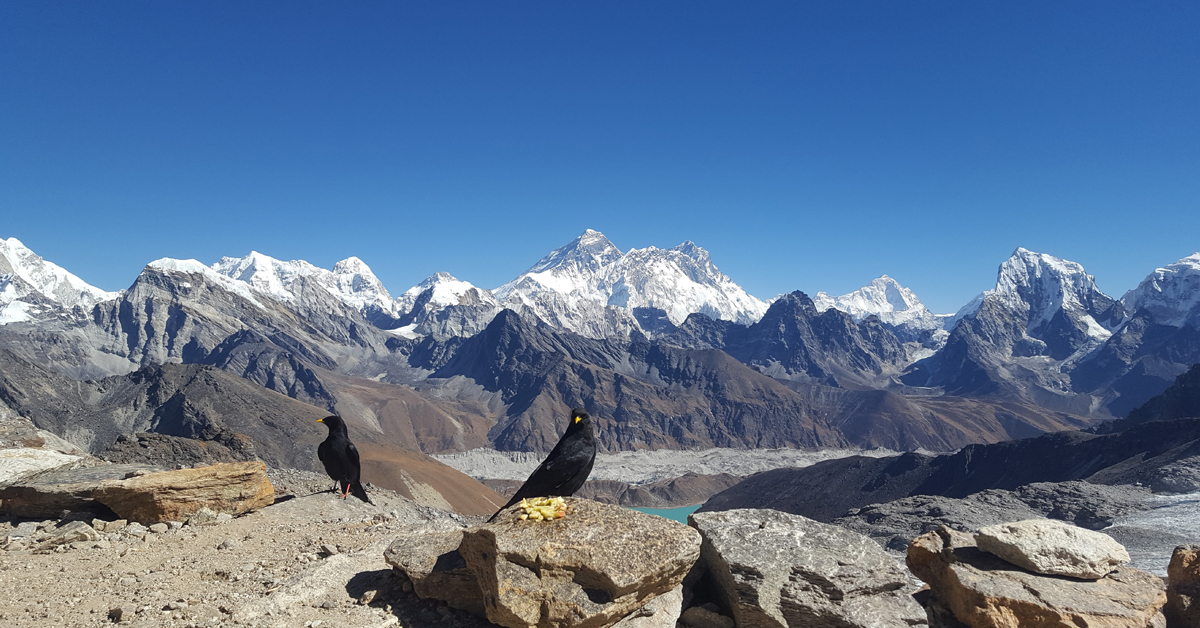
Highlights of the trip
- Wonderful vista from Renjo-La Pass
- Permitted to reach the 5,357-meter-high Gokyo Peak without a climbing permit
- Gokyo Lakes heritage land blue sky color
- The four highest mountain views at 8,00 meters are of the ancient Buddhist monasteries of Cho Yu, Lhotse, Everest, and Makalu.
- Sherpa cultural heritage
Best Time for the trek
The optimum months to start the Renjo la Pass walk are March through June and July, which is considered the spring season. Trekkers may fully immerse themselves in the breathtaking natural splendor of the area during these months thanks to the pleasant weather and superb visibility.
The scenery becomes a sensory extravaganza with blossoming flowers and lush foliage, adding to the trek’s allure. In addition, the trails are comparatively less congested at this time of year than they are during the busiest trekking season, guaranteeing hikers a more serene and pleasant experience.
On the other hand, the best time to hike Renjo la Pass is during the early months of September through December. This time frame corresponds to the autumnal season, which is characterized by consistent weather and mostly clear skies. The days are moderate enough to make trekking comfortable.
Trekkers can enjoy uninterrupted views of the spectacular Himalayas during autumn, thanks to the extraordinarily clear skies. Autumn uncovers breathtaking vistas of the surrounding mountains. As with spring, hiking Renjo la Pass in the fall has the benefit of being less crowded with other hikers on the routes.
The seasons that are best for visiting the isolated and pristine Khumbu Territory are spring and fall. Trekkers can enjoy the unspoiled beauty of the area and avoid the crowds that are frequently found on more popular trails by choosing the Renjo la Pass route. The Renjo la Pass hike ensures an amazing experience amidst the wonders of nature, regardless of whether one enjoys the vivid springtime scenery or the glistening autumnal vistas.
Route to go to this trek
The schedule for the Renjo la Pass Trek usually starts with a picturesque flight to Lukla, then continues with a trek down the enthralling Dudh Koshi River, culminating in Namche Bazaar. Trekkers head towards Renjo La passes after spending a day resting in Namche to acclimatize, passing via the quaint Sherpa settlement of Thame.
In comparison to the Tengboche side, this path is renowned for being less busy, providing a more tranquil experience. Lungden is a convenient stop along the journey, with basic accommodation options available. The journey returns to Dole, Namche, and Lukla after exploring the Gokyo Valley, and it ends with a flight back to Kathmandu.
If one has more days to spare on the Renjo la trekking experience, there are chances to submit multiple peaks. Two noteworthy choices are Nangkartshang Peak, also called Lungden Peak, and Sundar Peak in Thame.
Lungden Peak is situated along the ridge of the Renjo La Pass and rises to a remarkable 5,100 meters above sea level. Because of this, hikers who travel through Lungden hamlet on their way to Renjo la may be able to summit Lungden Peak on the same day. With their stunning surroundings, these extra peaks offer an exhilarating challenge and an opportunity to enhance the trekking experience further.
4. Larkey La Pass: Remote Beauty
Larkya La is located 5,106 meters above sea level. It is a crossroads for the routes leading to Bhimtang Valley and Manaslu Base Camp. The Larkya Peak is the source of the pass’s name. Situated in the Annapurna area, Larkya Peak is a 6,249-meter-tall mountain. The trail ascends Manaslu’s right sub-peak.
Larkya Pass is not far from the boundary between China and Nepal. Manaslu Conservation Area and Annapurna Conservation Area are connected by it. The Larkya Pass Trek is another name for trekking the Manaslu Circuit. The Manaslu circle trip requires hikers to traverse a high, drawn-out mountain pass.
How to reach Larkey La pass
You have to use a jeep to go to Arughat when you are exploring the Manaslu Circuit. After that, you will pass Jagat-Dyang-Ghap-Lho Gaun-Samagaon and arrive at Macha Khola. Samagaon is used as a place for acclimatization. To get to the Larke La Pass from Samagaon, you have to travel to Dharamsala. The place to go is Dharamsala, which is also called Larkya la Base Camp.
Stunning vistas of Samdo Peak, Naike Peak, Larke Peak, Cheo Himal, Manaslu North, and more can be seen during the trek. You should then return to the Larke Phedi. You’ll have plenty of time to adjust to the next location once you get to the Phedi. Typically, visitors spend the night and traverse the Larkya La Pass the next day.
The day to cross the Larkya La would be the next. Once you’ve slept and gained some momentum, you will reach the Larkya Glacier. Its path will climb quite gradually.
From here, one can see multiple peaks, including Annapurna II (7,937 meters), Himlung (7,126 meters), and Kang Guru (6,981 meters). They soar above 6,000 meters and are reachable from the peak. Prayer flags will start to fly in the breeze as you approach Bhimtang. You’ll cross the glacier moraine on an uneven, rocky track. However, it will be rewarding because of the stunning views of Larke Peak at daybreak.
The day to cross the Larkya La would be the next. Once you’ve slept and gained some momentum, you will reach the Larkya Glacier. Its path will climb quite gradually.
From here, one can see multiple peaks, including Annapurna II (7,937 meters), Himlung (7,126 meters), and Kang Guru (6,981 meters). They soar above 6,000 meters and are reachable from the peak. Prayer flags will start to fly in the breeze as you approach Bhimtang. You’ll cross the glacier moraine on an uneven, rocky track. However, it will be rewarding because of the stunning views of Larke Peak at daybreak.
Permits required for the trek
There are specific permits needed to access the Larkya La Pass. They align with the licenses issued for the standard Manaslu expedition. Three of these permits are available. The permits for the Annapurna Conservation Area (ACAP), the Manaslu Restricted Area (MRAP), and the Tourist Information Management System (TIMS). The first two licenses are particular licenses needed in the region. However, aside from specific routes, the TIMS permit is a generic trekking permit required to hike anywhere in Nepal.
Depending on the season you’re hiking, permits have different prices. The price per person during the winter, spring, and summer seasons is USD 145. Every extra day is charged at the rate of USD 7. The rate for seven days during the Autumn Season is USD 165 per person. then an extra ten dollars a day after that.
Difficulties of Larke La Pass
Altitude sickness
The longest and highest elevation pass in the Manaslu region is called Larkya La Pass. Among the highest trekking points on many Manaslu hikes is this location. Altitude sickness poses a significant risk pretty frequently. Thus, most people have a prearranged itinerary when they travel. A day or two before they arrive at the highest point, they acclimate. In addition, they cover less ground in a day before reaching the highest altitude.
Additionally, there is a decreased risk of altitude sickness when hiking with guides and porters. The guides are an experienced lot and can educate you on what to do. Similarly, a large weight will cause a burden if you suffer from altitude sickness. So think about having some porter as well.
Bringing along a first aid kit and medication, such as Diamox, will also be beneficial. The best defense against this kind of illness is to stay hydrated and stay away from coffee.
Harsh and Slope-Landform
One of the most isolated tourist destinations is the Manaslu region. The trek’s highest point is the Larkya La Pass, and the path is difficult above that. It has difficult icy pathways and is extremely steep. The roads will be quite difficult and highly troublesome, especially in the winter. You can become ill or suffer frostbite. Among a lot of other things, you could trip and fall on the icy paths.
However, these difficulties can be avoided by scheduling the hike for the right time of year. Go over the Larke La Pass in the fall or spring if you choose to. The trails will be extremely rugged due to the monsoon rains. Because of the icy paths and snowstorms, the winter will be more hazardous.
5. Tashi Lapcha Pass: A Mountaineer’s Challenge
The Gauri Shankar region of northeastern Nepal is home to the Tashi Lapcha Pass trek. The Tashi Laptsa Pass Trek includes contacts with a mythical character, history, and biodiversity. It also makes it possible to find the largest Tsho-Rolpa lake. It becomes a commerce route through Tashi Laptsa Pass connecting the Everest and Rolwaling regions.
Three popular hiking peaks are Melungste, Pachermo Peak, and Ramdung Peak. Since you can take in the seclusion of the Rolwaling Valley, it’s perfect in every way. See the remarkable and well-known Khumbu Valley as well as portions of the Everest base camp hike.
The Tashi Lapcha Pass Trek is among the hardest because of the frequent rockfalls and the numerous days of walking along the stunning glacier. Trekking to the Tashi Lapcha pass requires a Pachhermo peak climbing permit. The hiker needs to be knowledgeable about ice handling and well-prepared for icebergs and ice works. The trek to Tashi Lapcha Pass is difficult and takes place in the woods.
Trekking over Tashi Laptsa Pass provides a slightly different experience, but the breathtaking vistas of the high Himalayas remain the same. The greatest seasons to travel to this area are spring and fall, although we can make arrangements to camp throughout the year upon request. In 1951, Eric Shipton came into this hiking track while studying the footprints left by Yetis.
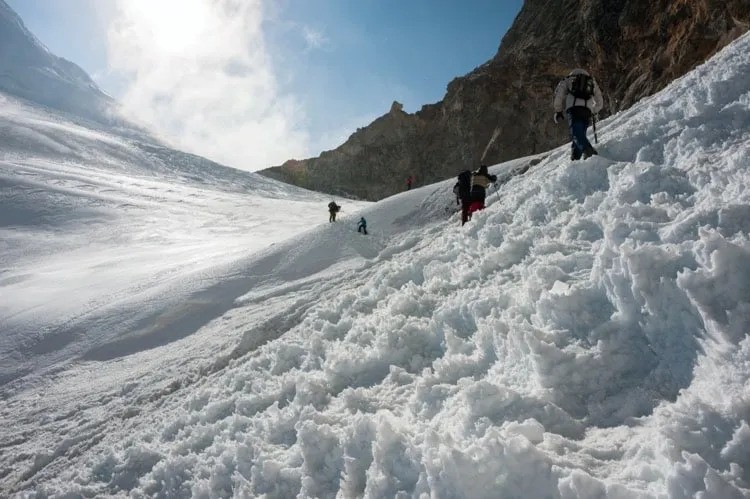
Highlights of the Tashi Lapcha Pass Trek
- Experience the breathtaking views of the upper Himalayas, including Gauri Shankar, Everest, Lhotse, and more.
- Visit the trekking area and investigate the Tso Rolpa glacier lake, at the very least.
- Admirable is the diverse scenery, and the second portion of the walk is quite the opposite.
- Passing through the concealed Rolwaling Valley, monasteries, and the 5,700-meter-high Tashi Lapcha Pass.
- Although Rolwaling Himal lacks a legally protected area, it is rich in flora, bird species, and animals, including black bears, leopard cats, and red pandas.
- Through Rolwaling Himal, the Buddhist culture of the Khumbu provides an opportunity to learn about the historical blending of Buddhism, Shamanism, and Hinduism.
Permits & regulations for Tashi Laptsa Pass Trek
A special license is required to access Rolwaling Valley, while Pachhermo Peak and Tashi Lapcha Pass are automatically merged. Thus, to finish this voyage, five separate permissions are needed. Seasonal variations in pricing are allowed at Pachhermo Peak.
- The restricted area in Rolwaling Valley costs $20 per person per week.
- Permit for Pachhermo Peak: US$ 250 (March–May), US$ 125 (September–November), US$ 70 (December–February), and US$ 70 (June–August).
- Project Name: Gauri Shankar Conservation Area (GCAP) US$28
- The National Park of Sagarmatha Passang Lhamu Rural Municipality, US$ 28. US$ 18.
Conclusion
Trekking across Nepal’s highest passes is a once-in-a-lifetime adventure that promises breathtaking scenery, cultural immersion, and personal achievement. Whether you choose the iconic routes of Thorong La and Chola La pass or opt for the lesser-known paths like Renjo La and Tashi Lapcha, each pass offers a unique blend of challenges and rewards. So get ready for the adventure of a lifetime in the Himalayas of Nepal. Start on a memorable journey through Nepal’s highest passes, where every step is a testament to the power of nature and the spirit of adventure.

